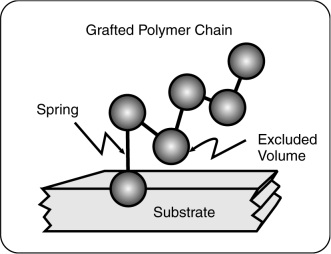An Example
Using the importance sampling method developed in the preceding section we can formulate the algorithm to sample conformatio of the end-grafted chain if we displace one monomer at a time as follows

Algorithm Grafted Polymer Chain
- From a uniform distribution draw a random number.
- Using this number choose a monomer from the chain
- From a uniform distribution draw three random numbers.
- Compute from these numbers a displacement.
- If the displacement has led to a violation of the excluded volume condition among the monomers or with the substrate reject the move. The old configuration in this case counts again. Go to 1.
- Otherwise perform the following steps.
- Compute the change in energy for the bond lengths.
- Compute the change in energy for the bond angles.
- Compute the change in energy
- From a uniform distribution draw a random number r.
- If
then accept the move and go to 1.
- Otherwise reject the move and the old conformation of the chain is counted again
- Go to 1.
What essentially makes this an importance sampling technique is the step 11 in the above algorithm. Consider generating a conformation of the chain at random. The random generation of the chain surely results in an energy for the conformation of the chain that is not compatible with the fixed temperature. In other words, the probability for such a conformation to occur at a fixed temperature is small. The probability distribution is peaked around conformations having an average energy determined by the conditions of fixed temperature. A random generation will not bring about conformations consistent with the constraints. The algorithm above does generate conformations consistent with the constraints. This can be seen by presenting an argument that is not entirely rigorous but gives insight why we sample the important contributions. For a rigorous derivation the reader is advised to go back to the previous section, if he has not done so.
The argument is as follows. Consider the system at very low temperature. Then we can take the energy of the system to be the free energy. At constant temperature the free energy and hence the energy in the case we consider must be minimized. The step 11 in the above algorithm does this minimization. If the energy is reduced by the move, then the change in energy is negative and the move is accepted. On the other hand, if the move generates a conformation of the chain with a higher energy, then the move is accepted only with a probability proportional to the Boltzmann weight. This ensures that once we are the bottom of a minimum of the free energy we can get out of a state. We may have ended in a relative minimum of the free energy! Accepting moves that raise the energy, we ensure that we can reach the absolute minimum.